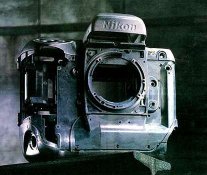But the F6 was made for an era that had Pro news and sport photographers migrated to D1 which mostly had the F5 body construction and durability.
The F6 was designed during a time period in which most professional and enthusiast photographers still used film. News and sport photographers aren't the only professional groups. I know from camera distributors at that time that in the first years lots of professional wedding, portrait, nature and travel photographers have bought the F6. In the "Nikon News" print magazine (for the German speaking markets) there was a report about a nature photographer who used the F6 for his arctic travels because of its robustness and reliability under extrem conditions.
Basicly the F6 is the F100 concept with F5 features upgraded, but lacking the solid pro construction and durability, and also lacking some top Pro refinements like interchangeable viewfinders, weather protected, which were an absolute challenge to design and to manufacture.
Sorry, but again completely wrong. Has nothing to do with the facts.
Interchangeable viewfinders have been abandoned by
all manufactures in their professional cameras long before ( 14 - 19 years) the F6 was introduced. Nikon abadoned it 1999 with the D1. This design was abondoned because professional photographers and the other customer bases much prefered the better weather sealed and in the long run more robust fixed prism design.
The F6 not only has a 100% pro construction and reliability, it is also significantly improved compared to the F5 in that regard: Better shutter reliability, improved weather sealing, better rubber coating design just to name some as examples. E.g. the F5 has the weakness that the rubber coating is loosening over time, no contact to the body anymore. Lots of F5s are suffering from it, the more you use it, the more often it happens. My F5 has that problem, too. Already during the F5 production time fixing F5s with loose rubber coatings was a regular task of the Nikon service.
And you definitely should read what a Nikon designer has to say about it, because he makes it very clear that Nikon wanted to surpass the F5 with the F6:
Quotes:
"And we want to make the F6 the
best camera in every aspect."
"We already had a high-speed, high-performance camera, the F5, in our lineup. In developing the F6, we intended to create a camera giving users
even more of what they want than the F5 does. The development concept for the F5 was “high speed and high performance.” With the F6, we aimed to
offer the functions of the F5, and also enhance the advantages of “finesse and practicality.”
"Even the sounds of shutter-release and other operations provide a
special sensation of quality. So what I mean by “finesse” is the comfortable, reassuring feel of
flawless operation transmitted through these three senses."
"In developing the F6, we were very attentive to maximizing operating comfort, even when the camera is subjected to
use under very tough conditions."
"I must say that we
reexamined all materials, although they had been used successfully in our existing cameras. Every single part was inspected from every aspect. We were not simply content with the current state of the art. Our attitude was to look for
something better in order to create the best camera."
"I know that
we achieved this because we were
afforded a longer period than usual to develop the best camera that we could create."
"
Does the F6 have larger buttons?
Yes, we decided to do that for the sake of easier operations. Operations can be
performed using gloved hands, as we assumed that the
F6 would be used in cold places, given the camera’s
supreme environment-proof performance.
We put the priority on ease of operation, and made the buttons large and lockless."
"
How have mechanics been improved?
The F5 successfully minimized shutter lag. We carried this superior characteristic over to the F6, and also tried to
maximize the finesse of the shutter. Specifically, we succeeded in our efforts to
reduce vibration and improve the quality of mechanical sounds, especially from the moment the shutter is pressed to the moment it is released. This was achieved by changing the way the shutter is fixed to the camera body. Normally, the shutter is fixed to the body using screws. But with the F6, we use a floating mechanism, in which the shutter is hung with rubber. This rubber absorbs vibration when the shutter is released."
"Not only did we minimize vibration, we spared no effort to keep operation quiet. To let users concentrate on shooting, we wanted to
eradicate any unnecessary sounds as much as possible, as well as minimize vibration. We were determined to follow a principle of keeping operating sound, even those heard only by the photographer, to an absolute minimum."
"Materials used for the F6 shutter-release button have been newly developed.
The shutter film material has also been changed for enhanced durability. The strictest Nikon standards have been applied to make the F6 a most reliable and durable camera."
"The design of F6 looks as if it is a definitive “standard,” compared with the F5.
I am confident that we have developed it carefully and conscientiously, making practicality the first priority, while maintaining and
even improving upon the high performance of the F5."
"Would you like to offer a closing comment?
I ask customers to try holding the F6, look into the viewfinder, and release the shutter. I am confident that the
F6 has achieved a new peak in its mechanics. But you cannot fully appreciate what the F6 can actually do, or how you can use it to greatest advantage, just by looking at its specifications table."
As someone who is using the F6 for more than a decade now, including professional use (wedding, portrait, advertizing shots), and as someone who is also using the F100, F4s, F5, I can conpletely confirm what is said by the Nikon designer about the superior performance.
and... what about the isolated fim transport ???? this is a core feature...
???
The F6 offers 8 fps like the F5. And in addition it surpasses the F5 with more silent operation, which is important in professional applications like wildlife, wedding and press photography. Film transport is definitely overall better designed in the F6.
It depends on how you use the AF, if using S with the internal motor (which is my case) the F5 blows the F6.
You have never used a F6, and you have never done a direct comparison test by yourself. Otherwise you wouldn't spread this prejudice-based misinformation. The F5 does not "blow" the F6 at all in AF. The F5 is just louder and worse vibration dampened in operation, so that some amateur fools who don't know how to do a proper test get fooled and get the impression it is faster. But it is not.
The professional construction, robustness and reliability of the F6 was a main design focus of the engineering team (see the quotes above). Therefore it was also presented with a strong focus in the F6 information brochure. It would take to much place to upload the whole brochure, therefore here just as examples I've uploaded some pages about the extraordinary precision and robustness (click on the thumbnail below, the other pictures will follow in separate posts because of technical upload restrictions).
You like your F5. That is fine, and I can completely understand that. Because I like my F5, too.
But you have never used the F6 by yourself. And your opinion about it is just based on prejudicies and misinformation / lies spread about it on the internet by armchair 'experts' who have not ever used a F6 either.
Regards,
Henning








 .
.
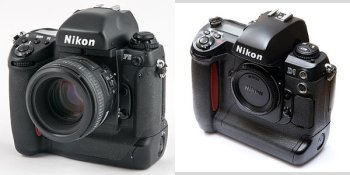




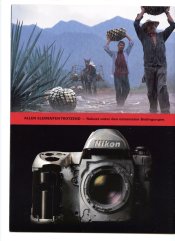
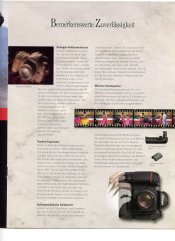
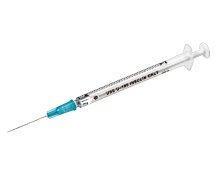
 ?
? .
.